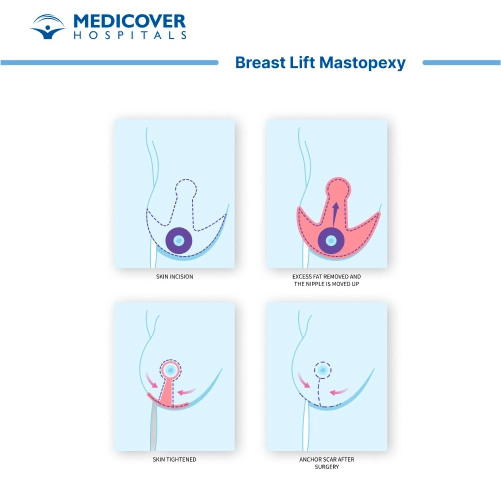A breast lift or mastopexy is a cosmetic surgical procedure designed to raise and reshape sagging breasts by removing excess skin and tightening the surrounding tissue. This procedure is ideal for women who have experienced loss of skin elasticity due to aging, pregnancy, breastfeeding or significant weight fluctuations.
A breast lift restores a more youthful breast by correcting drooping and repositioning the nipple higher on the breast mound. It is suitable for women with nipples that point downward, stretched areolas or asymmetrical breasts. The surgeon may use different incision techniques based on the amount of lift needed and whether implants are involved.


Types of Breast Lift Techniques
- Crescent Lift: Minimal lift using a small incision around the top half of the areola.
- Periareolar (Donut) Lift: Circular incision around the areola; suitable for mild sagging.
- Vertical (Lollipop) Lift: Around the areola and vertically down; good for moderate sagging.
- Anchor (Inverted-T) Lift: Combines incisions around the areola, vertically, and along the breast crease; ideal for large sagging.
Key Takeaways
- Type of Procedure: Surgical (cosmetic).
- Duration: 1.5 to 3 hours.
- Anesthesia Used: General anesthesia.
- Recovery Time: 2 to 6 weeks.
- Success Rate: High satisfaction rate (over 90% improvement in breast shape and contour).
Indications of Breast Lift Surgery (Mastopexy)
- Rest Ptosis: Corrects sagging due to aging or gravity.
- Loss of Breast Volume: Reshapes deflated breasts post-pregnancy or weight loss.
- Nipple and Areola Position: Repositions low/uneven nipples.
- Breast Asymmetry: Balances uneven breast shapes/sizes.
- Post-Pregnancy Changes: Restores pre-pregnancy breast shape.
- Aging Effects: Tightens sagging caused by loss of skin elasticity.
- Improved Proportions: Enhances body balance.
- Boosted Confidence: Improves self-esteem and body image.
Get a second opinion from trusted experts and makeconfident, informed decisions.
Get Second OpinionPreparation for Breast Lift Surgery
- Choose the Right Surgeon: Consult a certified breast lift surgery doctor.
- Medical Checkups: Complete mammograms/blood tests.
- Stop Smoking and Adjust Medications: Promote healing and disclose medications.
- Follow Pre-Surgery Instructions: Fast and avoid alcohol.
- Prepare Recovery Space: Set up essentials and loose clothing.
- Arrange Help: Assistance for chores/childcare.
- Get Prescriptions: Fill pain relief/antibiotics in advance.
- Hygiene: Clean skin thoroughly pre-surgery.
- Wear Comfortable Clothes: Front-opening top for easy access.
- Stay Healthy: Hydrate and eat nutritiously.
- Final Consultation: Confirm surgical plan and recovery details.
- Mental Preparation: Use relaxation techniques to manage stress.
Procedure for Breast Lift Surgery
- Anesthesia: Administered for comfort.
- Incisions: Made based on surgical technique.
- Reshaping: The tissue was lifted, and the excess skin was removed.
- Nipple Adjustment: Repositioned higher.
- Closing Incisions: Stitches and bandages applied.
- Supportive Garments: Surgical bra worn post-op.
- Recovery Room: Monitored until stable.
- Discharge: Same-day release with assistance.
Benefits of Breast Lift Surgery
- Improved breast shape and symmetry.
- Youthful nipple/areola position.
- Enhanced confidence and clothing fit.
- Long-lasting results with a healthy lifestyle.
- Reverses aging/pregnancy effects.
Risks and Complications of Breast Lift Surgery
Although breast lift surgery is generally safe when performed by a qualified surgeon, like any surgical procedure, it carries some risks and potential complications. These may include:
- Scarring: Permanent but usually fades over time. The extent depends on the surgical technique used and individual healing.
- Infection: Rare but can occur at incision sites. Proper treatment with antibiotics is effective.
- Changes in Nipple or Breast Sensation: Temporary or, in rare cases, permanent loss of sensation in the nipple or breast tissue.
- Asymmetry: Breasts may heal differently, resulting in uneven shape or nipple position, which might require revision surgery.
- Bleeding or Hematoma: Accumulation of blood under the skin may need surgical removal.
- Delayed Wound Healing: Incisions may take longer to heal, particularly in smokers or those with certain medical conditions.
- Poor Cosmetic Outcome: In rare cases, patients may be dissatisfied with the appearance of their breasts post-surgery.
- Breastfeeding Challenges: Although many women can still breastfeed, the ability may be reduced depending on the extent of the lift.
Non-Surgical Breast Lift Options
- Radiofrequency/Ultrasound: Tightens skin via collagen stimulation.
- Laser Therapy: Modest firming with light energy.
- Thread Lifts: Dissolvable sutures for subtle lift (12-18 months).
- Topical Creams/Massage: Temporary skin texture improvement.
Your health is everything - prioritize your well-being today.
Recovery After Breast Lift Surgery
Immediate Postoperative Period
- Observed in a recovery facility.
- Dressings/surgical bra applied.
- Pain is managed with prescribed medications.
First Few Weeks
- Rest and avoid heavy activities.
- Limit arm movement to reduce strain.
- Follow-up appointments to monitor healing.
- Swelling/bruising managed with cold compresses.
A Few Weeks to Months
- Gradually resume normal activities.
- Scar care with creams/silicone sheets.
- Final results are visible after months.